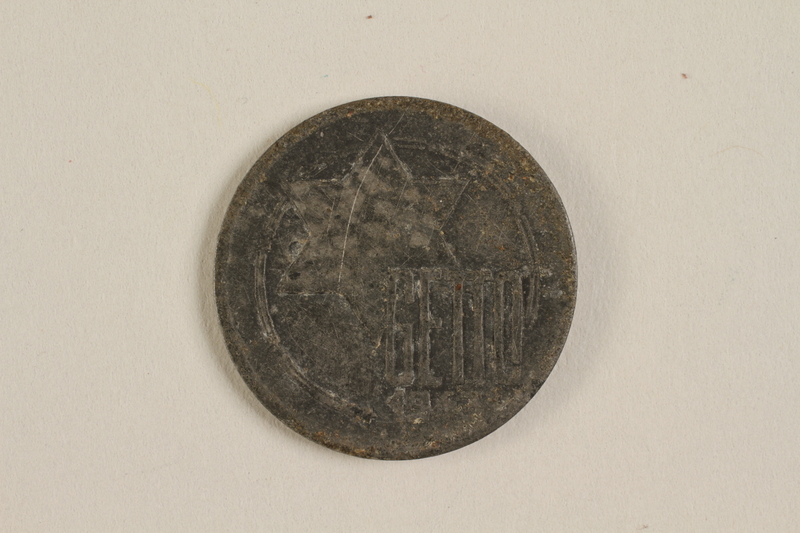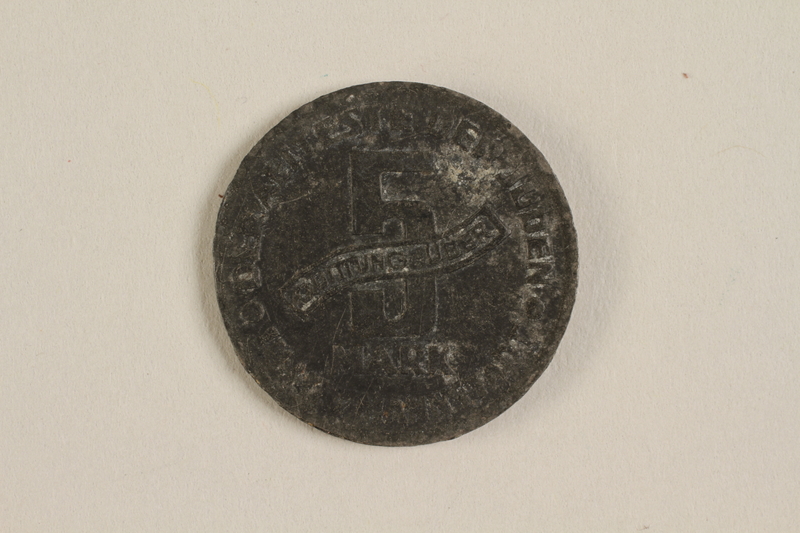Overview
- Brief Narrative
- Łódź Ghetto 5 mark coin token acquired by Edgar Gaerber, possibly when his family moved to Łódź in 1945. Ed, age 10, and his parents Dr. Bernard and Fanka Gaerber fled Lvov, Poland (L'viv, Ukraine] during the invasion by Germany in September 1939. The Soviet Union invaded from the east and the invaders divided the country; L'vov was in Soviet territory. In June 1941, Germany retook the region. The German occupation was brutal. Thousands of Jews were murdered in pogroms by local Ukrainians. In late 1941, Ed and his family had to relocate to the ghetto. In March 1942, the Germans began mass deportations to Belzec killing center. Ed's family got false identification papers and went into hiding, moving around to different towns. In July 1944, L'vov was liberated by the Soviet Army. In 1945, Ed and his parents moved to Łódź, Poland. The war ended when Germany surrendered on May 7. The family emigrated to Canada in 1949.
- Date
-
issue:
1943
- Geography
-
manufacture:
Litzmannstadt-Getto (Łódź, Poland);
Łódź (Poland)
- Credit Line
- United States Holocaust Memorial Museum Collection, Gift of Ed Gaerber
- Markings
- obverse: GETTO / 1943
reverse, around outside: DER AELTESTE DER JUDEN• / •IN LITZMANNSTADT [JEWISH ELDERS]
reverse, center: 5
reverse, banner across 5: QUITTUNG UBER
reverse, bottom: MARK - Contributor
-
Subject:
Ed Gaerber
Issuer: Der Aelteste der Juden in Litzmannstadt
- Biography
-
Edgar (Ed) Gaerber was born on August 28, 1929, in Lvov, Poland (Lʹviv, Ukraine) to Dr. Bernard and Fanka Rosenmann Gaerber. The family lived in Zloczow, about forty miles from Lvov, where Dr. Gaerber practiced medicine. He had met Fanka in Vienna while studying medicine. The Jewish population of the town numbered 6000, a majority of the population. The family was well off and Edgar’s father owned one of only four cars in town. In 1938, Fanka’s mother came to live with the family.
On September 1, 1939, Nazi Germany invaded Poland. In two weeks Lvov was surrounded and, a week later, the Soviet Union invaded from the east. The family left for Zaleszczyki planning to cross the border into Romania. At the crossing they met Jan Kwapinski, a Socialist and former mayor of Łódź, Poland. He convinced them not to flee Poland and that the Soviets would protect them. They returned to Lvov where the Soviets immediately confiscated Dr. Gaerber’s automobile. His medical practice was closed and he had to work at a clinic. Most businesses were nationalized and Jewish organizations were closed. Edgar attended a Russian school. Kwapinski stayed with the Gaerber family for a few months, then was deported to Siberia.
In June 1941, Germany retook the region when it invaded the Soviet Union. Edgar and his mother were in nearby Kalusz during the German invasion. They went to Lvov but later made their way back to Zloczow. The German occupation was brutal. Immediately after German troops entered Zloczow, the local Ukrainians organized a pogrom, during which 2000 Jews were murdered. Labor camps were set up and Jews were taken for forced labor. The Gaerber family had to leave their home and moved to an apartment above a drugstore. Edgar’s father prepared a hiding place between the floor of their apartment and the ceiling of the store and the four hid there during a roundup. In the spring 1942, Dr. Gaerber wrote to the daughter of Jan Kwapinski in Warsaw and asked for help. Her husband Jerzy Strzalkowski came to Zloczow and arranged to have photographs taken to make false identity documents for the family. Edgar’s maternal grandmother was placed in hiding near Zloczow. Jerzy drove to Zloczow in a truck to pick up Edgar and his parents, along with Hela Kitaj, Fanka’s friend, whose husband was murdered in the pogrom, and take them to Warsaw. They stayed for 3 or 4 nights in Belzec where a horrible smell permeated the air. They assumed identities as Roman Catholics, Dr Gaerber was Wladyslaw Sobieraj, a bookkeeper, Fanka was Zofia, a kindergarten teacher, and Edgar was now Wiktor, but called Garus by his parents. After a while, they moved to a nearby village, Jastrzeb. In spring1944, they found a place in Milanowek on the outskirts of Warsaw. They were discovered by the Germans and Edgar had to jump out a window. They hid elsewhere and their former Polish landlord robbed them of all valuables and they were now penniless. A Polish acquaintance gave them a key to his factory in Warsaw and they hid there. Dr. Gaerber was very sick with jaundice and even contemplated suicide. They moved to a village on the outskirts of the city, where Edgar, called Garus by his parents, stole fruit and vegetables from the neighboring farms to feed himself and his parents. Dr. Gaerber, who was a redhead, had to dye his hair black, since Polish stereotypes identified any redhead as a Jew. When they ran out of dye and could not afford more, he had to shave his head. There was a German military post on the farm where they were hiding and patrols were frequent. Dr. Gaerber had Strychnine pills ready in case they were discovered as Jews. A few weeks later, circa fall 1944, they moved again to a village near Lowicz. Edgar sold cigarettes to support the family.
In January 1945, the Soviet Army liberated the area. Edgar, his parents, and Hela Kitaj went to Warsaw, and then to Łódź. Dr. Gaerber set up a medical practice. Edgar began high school in Łódź. He traveled on his own to Warsaw and on one trip, passengers who recognized that he was Jewish threatened to throw him out the moving train. This and news of virulent anti-semitism in Poland made it clear to the family that they could not stay in Poland. In the fall 1946, they went to Paris, France. In 1949, they immigrated to Canada and settled in Regina, Saskatchewan. His father changed his specialization to psychiatry. Ed completed high school, then obtained a degree from McGill University. In 1961, Ed married Marilyn Jacobson, a native of Halifax, Nova Scotia. They settled in Vancouver, Canada, and had three sons. Ed was deeply involved with the local Jewish community. Ed, 83, passed away on December 28, 2012.
Physical Details
- Language
- German
- Classification
-
Exchange Media
- Category
-
Money
- Object Type
-
Tokens (lcsh)
- Physical Description
- Circular, silver colored metal coin, possibly aluminum or magnesium. The obverse has an embossed design with a 6 pointed Star of David, German text, and the year in the center over a circular line interspersed with Stars of David. There is a circle etched around the outer rim. The reverse has an embossed design with the denomination 5 mark in the center crossed by a banner with German text. There is German text engraved in a circle near the depressed rim.
- Dimensions
- overall: | Diameter: 0.875 inches (2.223 cm)
- Materials
- overall : metal
Rights & Restrictions
- Conditions on Access
- No restrictions on access
- Conditions on Use
- No restrictions on use
Keywords & Subjects
Administrative Notes
- Legal Status
- Permanent Collection
- Provenance
- The Lodz scrip was donated to the United States Holocaust Memorial Museum in 2003 by Ed Gaerber.
- Funding Note
- The cataloging of this artifact has been supported by a grant from the Conference on Jewish Material Claims Against Germany.
- Record last modified:
- 2024-02-01 09:07:14
- This page:
- https://collections.ushmm.org/search/catalog/irn521959
Download & Licensing
In-Person Research
- By Appointment
- Request 21 Days in Advance of Visit
- Plan a Research Visit
- Request to See This Object
Contact Us
Also in Edgar Gaerber collection
The collection consists of one paper note and five coins from the Łódź ghetto, an antisemitic calendar, seventeen false identification documents, and a publication relating to the experiences of Edgar Gaerber and his parents, Dr. Bernard and Fanka Gaerber, during the Holocaust in Lvov, Poland (L'viv Ukraine) and in hiding in nearby towns and after the Holocaust in Łódź, Poland.
Date: 1937-1945
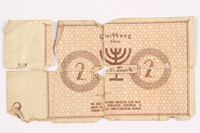
Łódź ghetto scrip, 2 mark note, in 3 pieces acquired by Polish Jewish survivor
Object
Łódź (Litzmannstadt) Ghetto scrip, receipt value of 2 (zwei) marks acquired by Edgar Gaerber, possibly when his family moved to Łódź in 1945. Ed, age 10, and his parents Dr. Bernard and Fanka Gaerber fled Lvov, Poland (L'viv, Ukraine] during the invasion by Germany in September 1939. The Soviet Union invaded from the east and the invaders divided the country; L'vov was in Soviet territory. In June 1941, Germany retook the region. The German occupation was brutal. Thousands of Jews were murdered in pogroms by local Ukrainians. In late 1941, Ed and his family had to relocate to the ghetto. In March 1942, the Germans began mass deportations to Belzec killing center. Ed's family got false identification papers and went into hiding, moving around to different towns. In July 1944, L'vov was liberated by the Soviet Army. In 1945, Ed and his parents moved to Łódź, Poland. The war ended when Germany surrendered on May 7. The family emigrated to Canada in 1949.
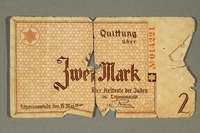
Łódź ghetto scrip, 2 mark note, acquired by Polish Jewish survivor
Object
Łódź (Litzmannstadt) Ghetto scrip, receipt value of 2 (zwei) marks acquired by Edgar Gaerber, possibly when his family moved to Łódź in 1945. Ed, age 10, and his parents Dr. Bernard and Fanka Gaerber fled Lvov, Poland (L'viv, Ukraine] during the invasion by Germany in September 1939. The Soviet Union invaded from the east and the invaders divided the country; L'vov was in Soviet territory. In June 1941, Germany retook the region. The German occupation was brutal. Thousands of Jews were murdered in pogroms by local Ukrainians. In late 1941, Ed and his family had to relocate to the ghetto. In March 1942, the Germans began mass deportations to Belzec killing center. Ed's family got false identification papers and went into hiding, moving around to different towns. In July 1944, L'vov was liberated by the Soviet Army. In 1945, Ed and his parents moved to Łódź, Poland. The war ended when Germany surrendered on May 7. The family emigrated to Canada in 1949.
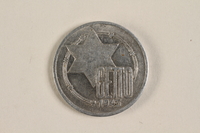
Łódź (Litzmannstadt) ghetto scrip, 10 mark coin acquired by Polish Jewish survivor
Object
Łódź Ghetto 10 mark coin token acquired by Edgar Gaerber, possibly when his family moved to Łódź in 1945. Ed, age 10, and his parents Dr. Bernard and Fanka Gaerber fled Lvov, Poland (L'viv, Ukraine] during the invasion by Germany in September 1939. The Soviet Union invaded from the east and the invaders divided the country; L'vov was in Soviet territory. In June 1941, Germany retook the region. The German occupation was brutal. Thousands of Jews were murdered in pogroms by local Ukrainians. In late 1941, Ed and his family had to relocate to the ghetto. In March 1942, the Germans began mass deportations to Belzec killing center. Ed's family got false identification papers and went into hiding, moving around to different towns. In July 1944, L'vov was liberated by the Soviet Army. In 1945, Ed and his parents moved to Łódź, Poland. The war ended when Germany surrendered on May 7. The family emigrated to Canada in 1949.
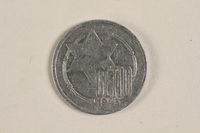
Łódź (Litzmannstadt) ghetto scrip, 10 mark coin acquired by Polish Jewish survivor
Object
Łódź Ghetto 10 mark coin token acquired by Edgar Gaerber, possibly when his family moved to Łódź in 1945. Ed, age 10, and his parents Dr. Bernard and Fanka Gaerber fled Lvov, Poland (L'viv, Ukraine] during the invasion by Germany in September 1939. The Soviet Union invaded from the east and the invaders divided the country; L'vov was in Soviet territory. In June 1941, Germany retook the region. The German occupation was brutal. Thousands of Jews were murdered in pogroms by local Ukrainians. In late 1941, Ed and his family had to relocate to the ghetto. In March 1942, the Germans began mass deportations to Belzec killing center. Ed's family got false identification papers and went into hiding, moving around to different towns. In July 1944, L'vov was liberated by the Soviet Army. In 1945, Ed and his parents moved to Łódź, Poland. The war ended when Germany surrendered on May 7. The family emigrated to Canada in 1949.
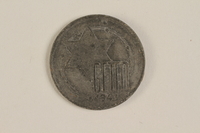
Łódź (Litzmannstadt) ghetto scrip, 5 mark coin acquired by Polish Jewish survivor
Object
Łódź Ghetto 5 mark coin token acquired by Edgar Gaerber, possibly when his family moved to Łódź in 1945. Ed, age 10, and his parents Dr. Bernard and Fanka Gaerber fled Lvov, Poland (L'viv, Ukraine] during the invasion by Germany in September 1939. The Soviet Union invaded from the east and the invaders divided the country; L'vov was in Soviet territory. In June 1941, Germany retook the region. The German occupation was brutal. Thousands of Jews were murdered in pogroms by local Ukrainians. In late 1941, Ed and his family had to relocate to the ghetto. In March 1942, the Germans began mass deportations to Belzec killing center. Ed's family got false identification papers and went into hiding, moving around to different towns. In July 1944, L'vov was liberated by the Soviet Army. In 1945, Ed and his parents moved to Łódź, Poland. The war ended when Germany surrendered on May 7. The family emigrated to Canada in 1949.
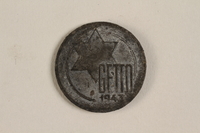
Łódź (Litzmannstadt) ghetto scrip, 5 mark coin acquired by Polish Jewish survivor
Object
Łódź Ghetto 5 mark coin token acquired by Edgar Gaerber, possibly when his family moved to Łódź in 1945. Ed, age 10, and his parents Dr. Bernard and Fanka Gaerber fled Lvov, Poland (L'viv, Ukraine] during the invasion by Germany in September 1939. The Soviet Union invaded from the east and the invaders divided the country; L'vov was in Soviet territory. In June 1941, Germany retook the region. The German occupation was brutal. Thousands of Jews were murdered in pogroms by local Ukrainians. In late 1941, Ed and his family had to relocate to the ghetto. In March 1942, the Germans began mass deportations to Belzec killing center. Ed's family got false identification papers and went into hiding, moving around to different towns. In July 1944, L'vov was liberated by the Soviet Army. In 1945, Ed and his parents moved to Łódź, Poland. The war ended when Germany surrendered on May 7. The family emigrated to Canada in 1949.
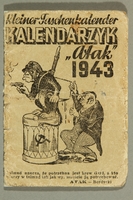
Calendar with cover of a Jew leading a Bolshevik monkey
Object
Antisemitic calendar with a caricature of a Jewish man holding the chain of a monkey that represents the Soviet Union owned by Edgar Gaerber. Ed, age 10, and his parents Dr. Bernard and Fanka Gaerber fled Lvov, Poland (L'viv, Ukraine] during the invasion by Germany in September 1939. The Soviet Union invaded from the east and the invaders divided the country; L'vov was in Soviet territory. In June 1941, Germany retook the region. The German occupation was brutal. Thousands of Jews were murdered in pogroms by local Ukrainians. In late 1941, Ed and his family had to relocate to the ghetto. In March 1942, the Germans began mass deportations to Belzec killing center. Ed's family got false identification papers and went into hiding, moving around to different towns. In July 1944, L'vov was liberated by the Soviet Army. In 1945, Ed and his parents moved to Łódź, Poland. The war ended when Germany surrendered on May 7. The family emigrated to Canada in 1949.
Gaerber family papers
Document
The papers consist of 17 false documents that enabled the Gaerber family of Lvov, Poland (Lʹviv, Ukraine) to survive the Holocaust.
Photobook
Object
Book published soon after the war featuring photographs of atrocities against Polish Jews in German occupied Poland acquired by Edgar Gaerber. Ed, age 10, and his parents Dr. Bernard and Fanka Gaerber fled Lvov, Poland (L'viv, Ukraine] during the invasion by Germany in September 1939. The Soviet Union invaded from the east and the invaders divided the country; L'vov was in Soviet territory. In June 1941, Germany retook the region. The German occupation was brutal. Thousands of Jews were murdered in pogroms by local Ukrainians. In late 1941, Ed and his family had to relocate to the ghetto. In March 1942, the Germans began mass deportations to Belzec killing center. Ed's family got false identification papers and went into hiding, moving around to different towns. In July 1944, L'vov was liberated by the Soviet Army. In 1945, Ed and his parents moved to Łódź, Poland. The war ended when Germany surrendered on May 7. The family emigrated to Canada in 1949.

